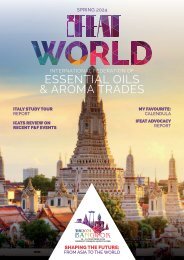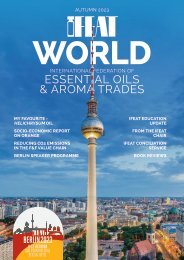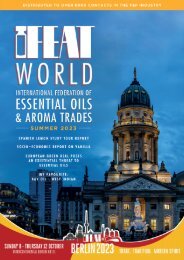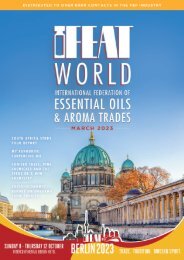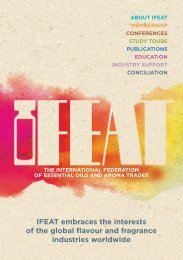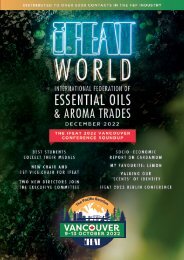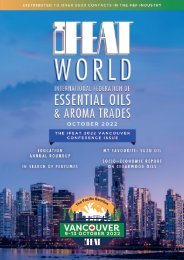IFEATWORLD July 2022
A Members' Newsletter for the International Federation of Essential Oils & Aroma Trades.
A Members' Newsletter for the International Federation of Essential Oils & Aroma Trades.
You also want an ePaper? Increase the reach of your titles
YUMPU automatically turns print PDFs into web optimized ePapers that Google loves.
30<br />
WORLD<br />
IFEAT SOCIO–ECONOMIC REPORT ON CEDARWOOD OILS<br />
RECEIVERS AFTER DISTILLATION<br />
SEPARATING CEDRENE AND CEDROL FROM THE CRUDE OIL<br />
After a number of years, the roots are<br />
extracted from the ground, cut into<br />
pieces, and ground into sawdust, which<br />
is then steam-distilled or dry-distilled<br />
into cedarwood oil. This contrasts<br />
with Texas and Virginiana cedarwood<br />
oils from the USA where no oils are<br />
obtained from root extraction.<br />
The abandoned tree stumps and roots<br />
are collected by farmers and each<br />
year there are an estimated 1.3 million<br />
abandoned cedar and firwood stumps.<br />
There is no particular harvesting<br />
season, farmers go and extract the<br />
abandoned tree stumps and roots<br />
when they are free except during the<br />
rainy season. There is a preference for<br />
wild tree stumps and roots because the<br />
oil yield is higher than replanted trees,<br />
even if the latter are many decades old.<br />
The older the tree stumps the higher<br />
the oil yield. The wild abandoned tree<br />
stumps are now usually deep in the<br />
mountains and to dig and transport<br />
them is not only hard physical work but<br />
also increasingly expensive as living<br />
costs increase in China. The willingness<br />
to undertake this work is mainly<br />
dependent on the price of cedarwood<br />
oil and its derivatives, and low prices<br />
prior to the COVID pandemic led to<br />
farmers and processors becoming<br />
less interested in this business and<br />
switching to other economic activities.<br />
The stumps are either sold to oil<br />
processors or are stored outside<br />
farmers’ houses waiting for a better<br />
price. Oil manufacturers chop the<br />
stumps and roots into pieces using<br />
machines and then steam or dry distill<br />
the pieces to obtain crude oil. If the<br />
oil is made by dry distillation it has a<br />
burnt odour, which was a typical odour<br />
of Chinese cedarwood oil. The drydistillation<br />
process has been gradually<br />
disappearing because of the oil’s burnt<br />
odour and it was not good for the<br />
environment leading to government<br />
prohibition. During the last five years or<br />
so, no dry distillation has taken place<br />
in China. Steam-distillation makes a<br />
good odour and customers can use this<br />
oil directly in fragrances. As discussed<br />
earlier, the crude oil can then be<br />
further processed using distillation,<br />
rectification, and chemical synthesis<br />
technologies into a range of aroma<br />
chemical derivatives. After distillation<br />
and processing, further products can<br />
be produced from the remaining waste<br />
products.




